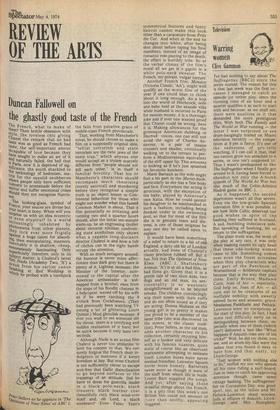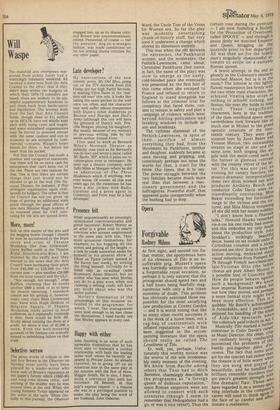Television
Warring women
Clive Gammon
I've had nothing to say about The Suffragettes (BBC2) since the series started. The reason for this is that last week was the first occasion I managed to catch an episode (or rather play, since the running time of an hour and a quarter qualifies it as such to start with and because, as we shall see, there were qualities in it that demanded the more prestigious title). With both The Family and The World at War running — the latter I was surprised to see drurn-bangingly trailed on Miami television recently — the competition at 9 pm is fierce. It's one of the sadnesses of pro telly watching, if I can call it that, that one cannot grow too attached to a series, or one isn't supposed to. Thus I wasn't predisposed to like The Suffragettes when I finally got around to it, having been forced to abandon not only the A-bomb episode of The World At War but also much of the Celtic-Atletico Madrid game on BBC 1.
As it happened, the second deprivation wasn't all that severe. Even via the low-grade Spanish television film it was possible to see how little Celtic deserved our good wishes in spite of the bashing they suffered in Scotland. A sad, bumbling indecisive side. But speaking of bashing, let us , return to the suffragettes.
The plain truth was, for most of the play at any rate, it was only when bashing reared its ugly head that these odd-looking women came to life. Something comes over even the finest actresses when they play characters who are part of the Pantheon of Womanhood — deliberate capitals because that is the way they play them. Emily Bronte, Madame Curie, Joan of Arc — especially, God help us, Joan of Arc — all turn out to be creatures of an ineffable nobility with sweetly pained faces and anaemic grace. Mesdames Pankhurst and PethickLawrence were no exceptions at the start of this play. In fact, I had some real difficulty early on in distinguishing between them, es pecially when one of them (which one?) delivered a line like "What happens if Asquith.tries any of his tricks?" Well, he did try them, you see, and so arum-lily-like were the ladies that you found it easy to hate him and that nasty, sly Lloyd-George. "Just women with nothing else to do," sniffed my son who spends all his time riding a surf-board. Just in time to catch his approving attention though, came some vintage bashing. The suffragettes' fair on Coronation Day, was good sport, too, as the ladies and Mr Pethick-Lawrence shied wooden balls at effigies of Asquith, LloydGeorge and Mrs Humphrey
Ward, the Uncle Tom of the Votes for Women era. So far the play was ,modestly entertaining chunk-of-history stuff, but very soon it underwent a change which altered its dimension entirely.
This was when the rift between the extremists, the Pankhurst women, and the moderates, the Pethick-Lawrences, came about. Christabel Pankhurst (her name, in fact, the name of the play) was slow to emerge as the nasty, cold-blooded piece she eventually was presented as: the first hint of this came when she escaped to France and refused to return to England to stand alongside her fellows at the criminal trial for conspiracy that faced them, content to remain in safety and plan a campaign of violence which went beyond hitting policemen and breaking windows to include arson and bombings.
The ruthless dismissal of the Pethick-Lawrences, in spite of their sacrifice of almost everything they had, from the Movement by Pankhurst, mother and daughter, suddenly became at once moving and gripping, and, consciously perhaps but none the worse for that, a tract for the times. Our times, that is to say. The power struggle between the two families became much more real than that between a reactionary government and the suffragettes. Powerful stuff, that appeared quite unexpectedly when the bashing had to stop.



































 Previous page
Previous page